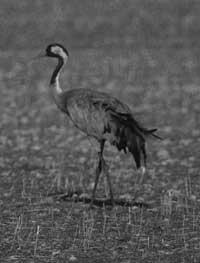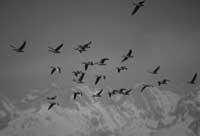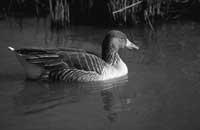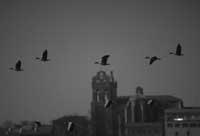Line to the south

The truth is that for some time I wanted to write about these birds, but I did not know if they could be considered as from the Basque Country and therefore if I could enter this section. Normally, we take as autochthonous the animals that are raised there and no one would doubt that, for example, the cespitose, the white vultures or the black milanos are autochthonous.
However, some of them come from Africa, raise and the little birds return to the southern bed after leaving the nest, so they only spend a third of the year there. Although the rest is in Africa, we consider these birds as autochthonous, while the goose, born in Norway, who was here from November to March, is winter. We, however, as these birds can give much of their life in this territory and, in addition, geese and cranes are well known animals for the Basques, we have included them in our usual section.
Geese ( Anser anser) and common cranes ( Grus grus grus) are typical passing birds of late October and early November, and for both the Iberian Peninsula is the most important wintering region. After their breeding in northern Europe and before winter comes, they head south to latitudes that facilitate contact with food. Scandinavia, the former Soviet Union and, in general, run from north to south of Europe and travel more than 2,000 to 3,000 kilometers to the winter lands. They cross the Pyrenees through the center, through the western hills and, once arrived to the Iberian Peninsula, they go to certain favorite territories.

The geese travel mainly to Andalusia and specifically to the marshes of the Guadalquivir to spend the winter. In addition, the lagoons of Villafafafafila, located in Zamora, are of vital importance for the coming goose. In both areas, and in other wetlands with lower concentrations of birds, 80 to 150,000 geese per year winter in the Iberian Peninsula. If they are left in peace they also remain in the Basque Country and around reservoirs like Pitillas, Urdaibai or Vitoria-Gasteiz, every year there is some balance. Geese feed on herbs and bulbs surrounding wetlands.
For the cranes, the angios of the southwest and the lagoon of Gallocanta in the area of Zaragoza and Teruel are the preferred places. In total, between 50,000 and 55,000 cranes (70-85% of the population of Western Europe) come to the Iberian Peninsula and normally in Euskal Herria only short stops are made. During the winter they feed mainly acorns and dating.

Let us now try to distinguish these great birds. Both geese and cranes are very large birds. The geese weigh between 2.5 and 4 kilos and the cranes of 4-7 kilos. As indicated, both species can form groups in the form of “V”, but can be distinguished by other characteristics. For example, in singing not to disperse the group, which can be heard very far and is easily distinguished: the singing of the cranes “kruu-krui-kruu” and the “anj-onj-onj”. In addition to singing, the appearance of both birds is different. Both carry the neck stretched when flying, but the geese have short legs and the cranes are ditch and their legs are much longer than the tail in the sky. Geese, finally, have wings sharper than cranes and fly with faster fin strokes.
It should be noted, moreover, that like these two species, many migratory birds tend to associate in groups. It seems that, among other advantages, young people united in group go behind the elderly to learn roads, dangers, stop areas, etc. And, on the other hand, aerodynamic “V” and similar formations allow birds to save energy, as do cyclists, removing air from each other.

As for the status and future of species, it seems that crane populations remain stable, but the similar ones do not. It seems that the droughts of recent years have caused great mortality among the geese, both due to the shortage of food and the need to move more by killing many hunters. In these cases, the specimens that have migrated to the Iberian Peninsula grow more successfully those that have remained further north, since fewer specimens die.
If this trend persisted, the number of geese coming to the Peninsula in some generations could decrease in a few years. This is the case of the ducky goose ( Anser fabalis). 50 years ago, 50,000 geese of this species wintered in the Iberian Peninsula and today only some specimens remain. It seems that this goose has changed its customs and winter is occurring ever beyond the breeding territory. Some experts believe that this trend may be related to climate warming, but more studies will be needed to confirm it.
In any case, we can still see the groups of cranes and geese shaped like an arrow in this tenor and crossing the sky at full speed... they announce that the winter remains for us.





